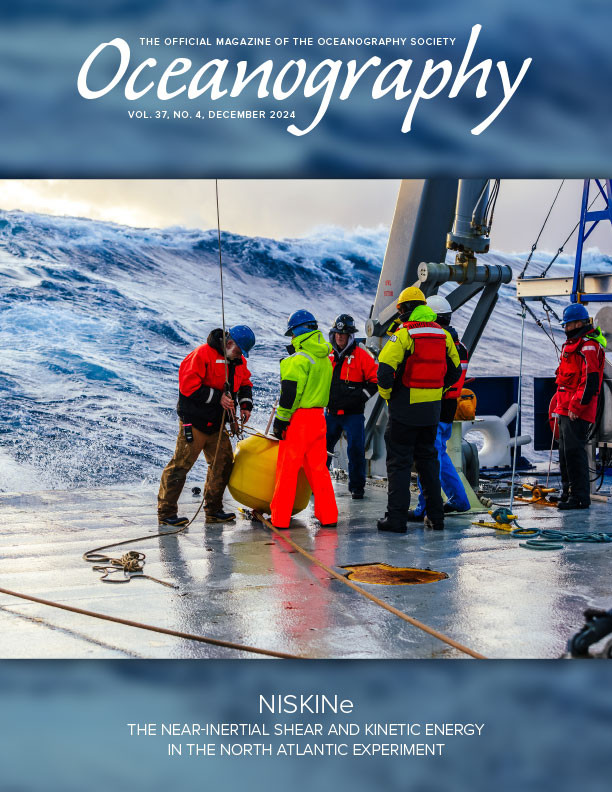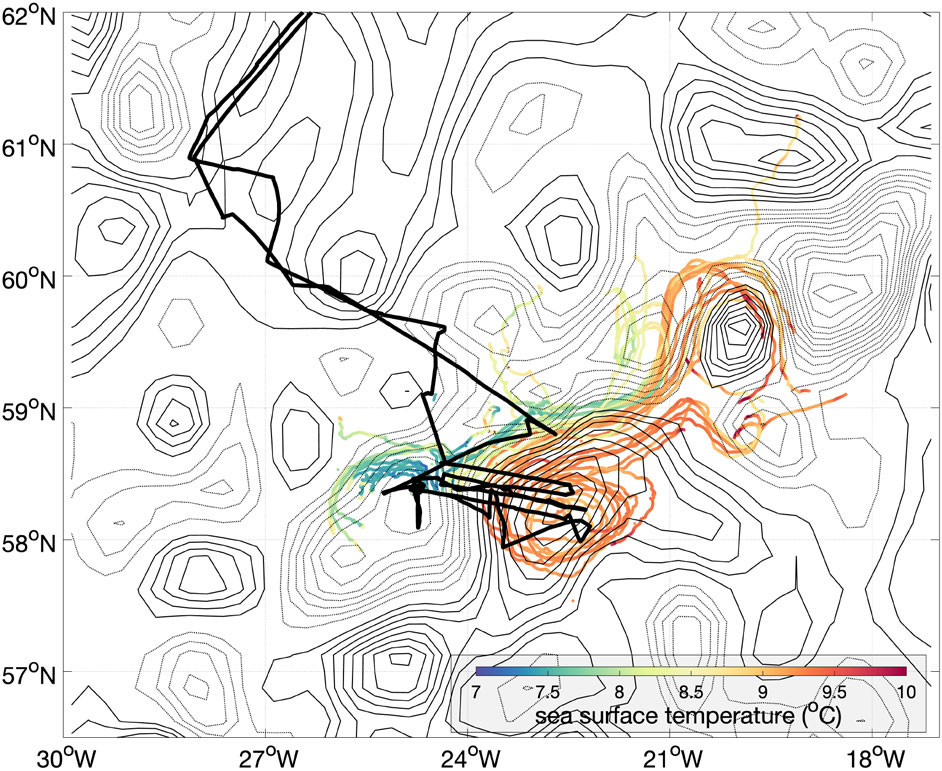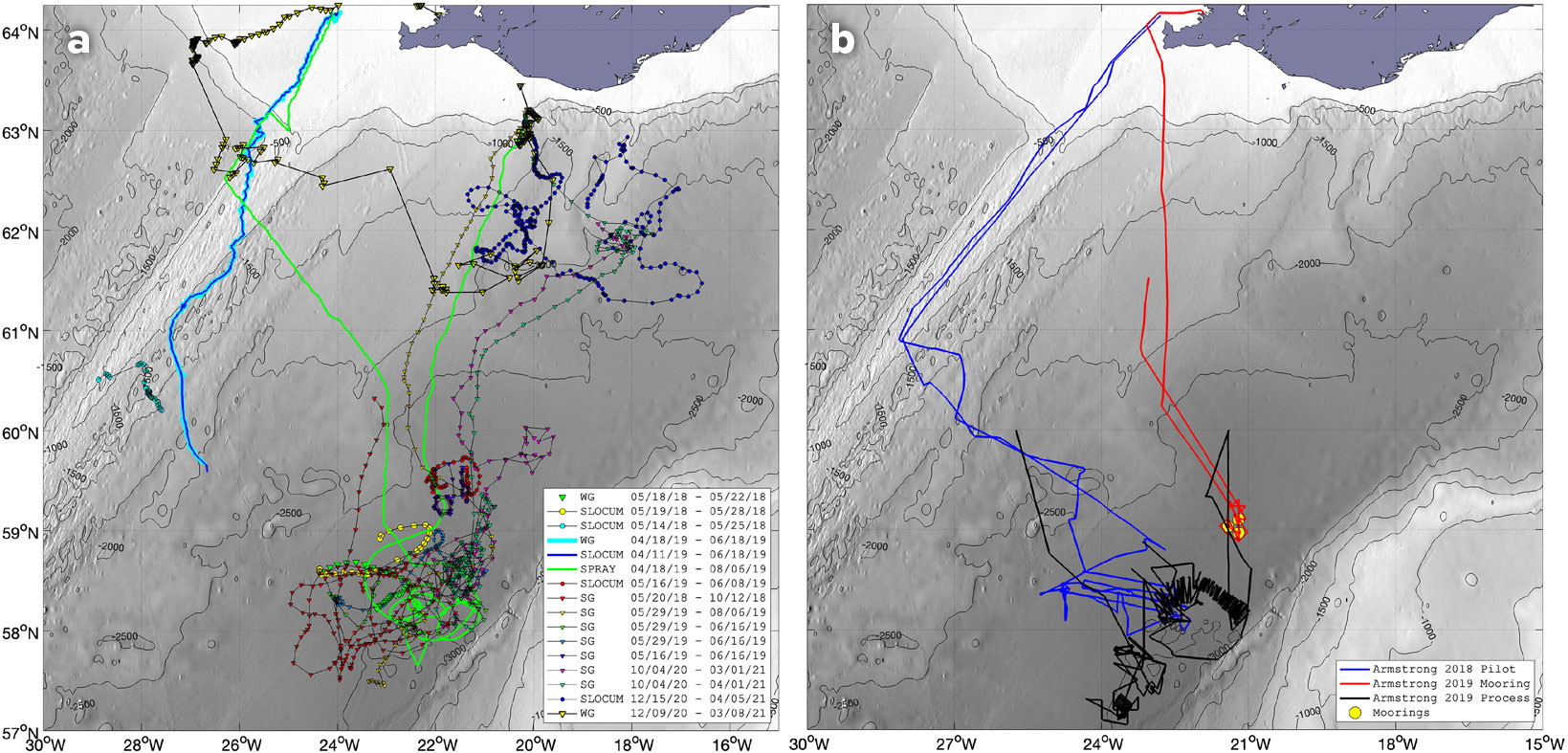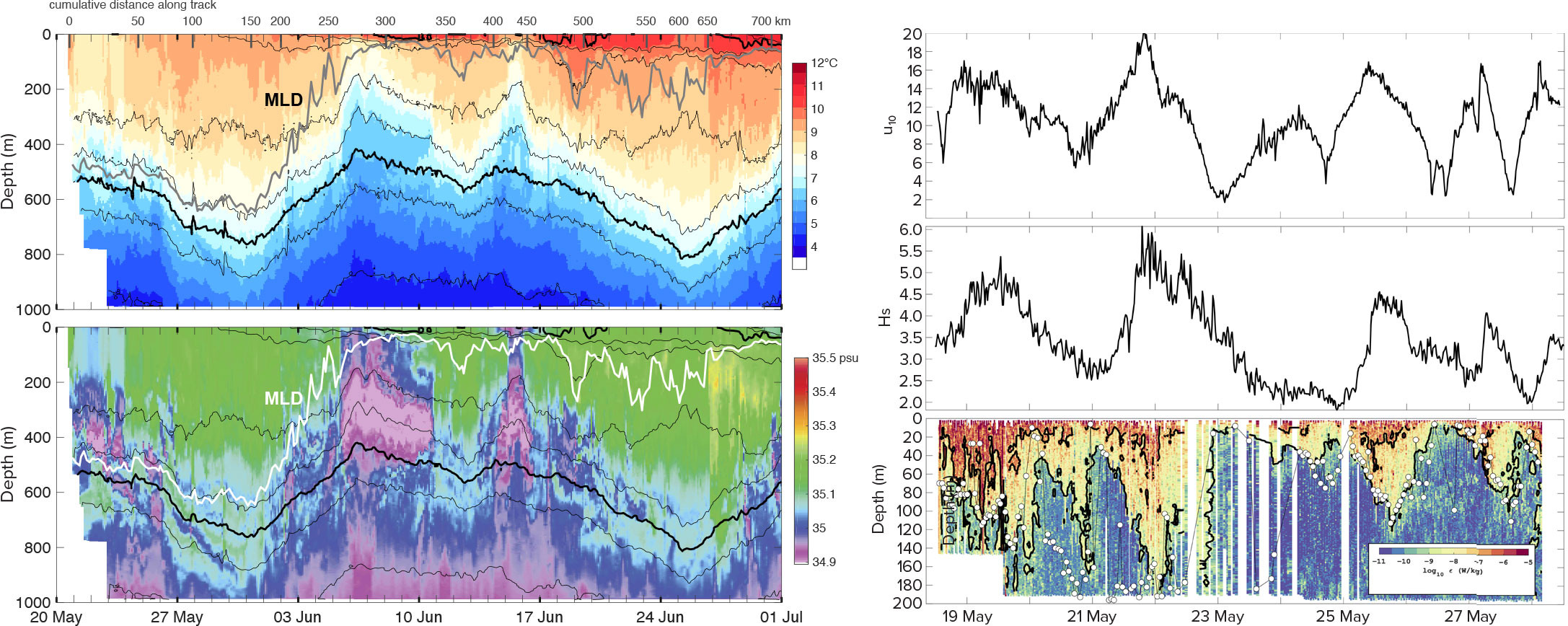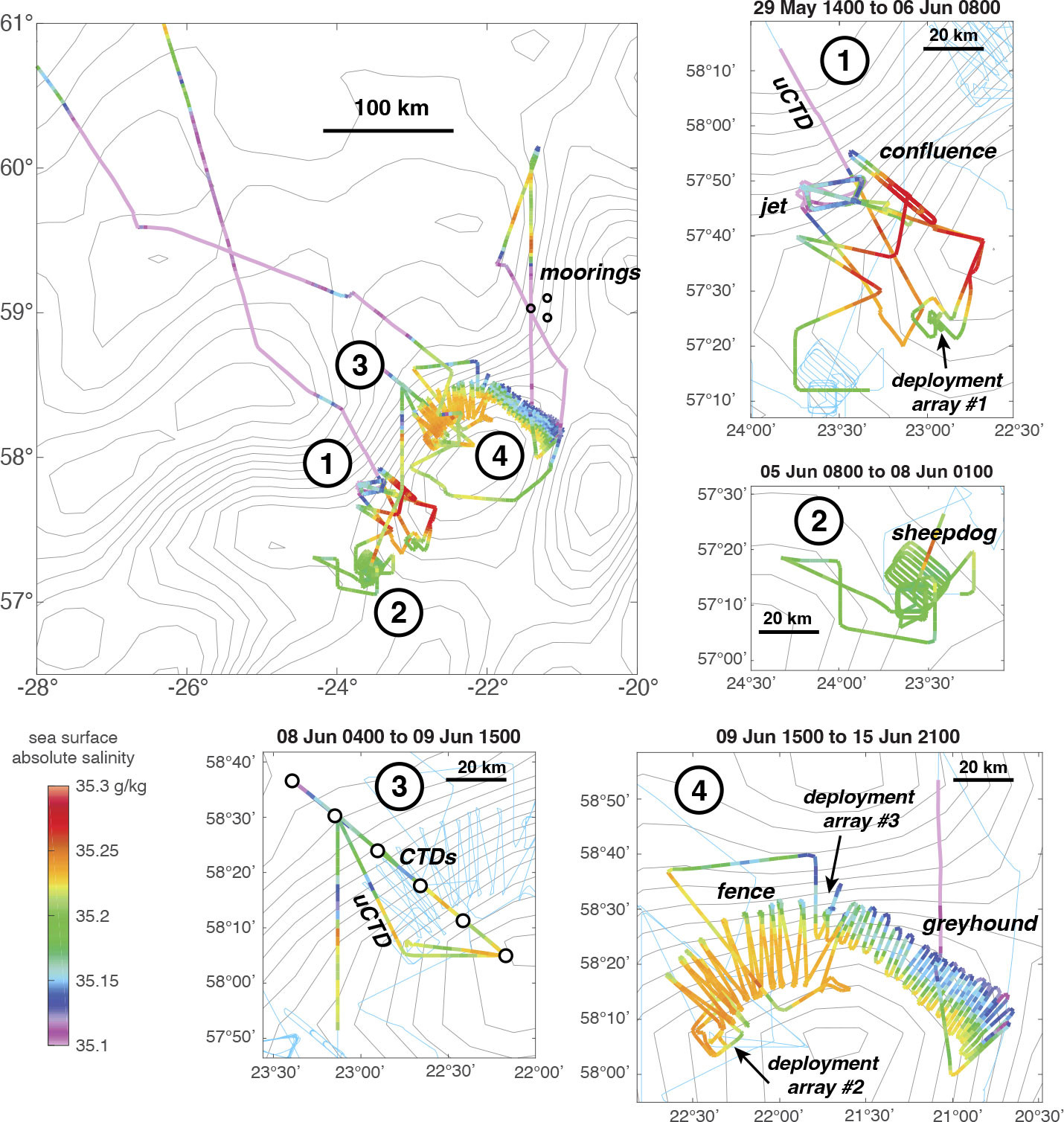Full Text
Introduction
Near-inertial internal waves (NIW) constitute a dominant mode of high-frequency variability in the ocean’s interior, comprising about half the kinetic energy in the ocean at most sites (and even more in the winter beneath storm tracks; Alford et al., 2016). Over the last decade there has been a significant focus in the physical oceanographic community on internal tides, which produce large thermocline displacements, affect sound propagation, and control some hotspots of elevated turbulent mixing. Near-inertial internal gravity waves, which are primarily generated not by tides but by winds, are of similar importance, providing comparable kinetic energy and the vast majority of the shear variance, and likely leading to a substantial amount of turbulent mixing. Significant deficiencies remain in our understanding of the physical processes that determine their generation, evolution, and destruction.
No existing regional or global numerical models fully account for the generation, radiation, and breaking of NIWs, largely because of the need for high resolution to resolve the high-mode structure and because the physics is not sufficiently understood. The NIW problem has been difficult to address, partially due to the episodic nature of wind generation and the nonlinear physics involved. The seminal experimental study of NIWs was the Ocean Storms Experiment (OSE), which took place in the late 1980s (D’Asaro et al., 1995). The main focus of the OSE was on the larger-scale lateral structure of NIWs, which theory predicts is shaped by Earth’s curvature through the so-called beta effect (Gill, 1984). During the OSE, the role of the beta effect in leading to the initial growth of horizontal gradients in the NIW field was clearly demonstrated, leading to a qualitative agreement with theory. However, the theory could not reproduce the observed “beam,” wherein energy migrated quickly downward with time from the mixed layer following storm events. An important consequence is that neither the decay of mixed-layer motions nor the rate of energy transfer into the deep ocean can adequately be predicted for the best-documented storm response on record. This conundrum has remained for the past 35 years since these data were collected, in part because the OSE data lacked sufficient vertical and horizontal resolution to quantify the detailed structures of the NIWs and their evolution. Moreover, the vital question of the distribution of mixing by the NIWs was unaddressed by the OSE.
Motivated by these questions, in 2016 the US Office of Naval Research sponsored the Near-Inertial Shear and Kinetic Energy in the North Atlantic experiment (NISKINe). The objective was to examine how NIWs rapidly radiate out of the mixed layer by developing smaller-scale horizontal structures through interaction with ocean eddies and how NIWs generate turbulence and mixing. Conducted in the eddy-rich, stormy North Atlantic during certain periods from 2018 to 2020, NISKINe utilized conceptualized studies, numerical modeling, and the latest technology to make direct, high-resolution observations of the NIW field to examine the physics. Here, we describe some highlights of the multi-year study and introduce a collection of articles that elaborate on the findings.
NISKINe
NISKINe combined observational, modeling, and theoretical approaches to underpin the at-sea science. The program integrated results from three field years in the Iceland Basin: a 2018 pilot study, a 2019 full-scale deployment, and a modest (pandemic impacted) effort in 2020. These data collection efforts were central to NISKINe, as they formed the basis for theoretical and process-oriented modeling efforts. Process-oriented studies that addressed NIW generation, NIW-eddy interactions, and the role of surface waves in affecting the energy input to NIWs included those by Asselin and Young (2020), Asselin et al. (2020), Barkan et al. (2021), Skyllingstad et al. (2023), and Stokes et al. (2024). These detailed works were framed by studies utilizing global ocean models for broader understanding of NIW significance including Arbic et al. (2022), Raja et al. (2022), and Yang et al. (2023).
For the 2018 pilot experiment, a dipole in the Icelandic Basin identified from satellite altimetry was selected as the study site (Figure 1). The particular dipole targeted was identified in the weeks prior to the onset of the cruise. The study consisted of several weeks of direct measurements from R/V Neil Armstrong augmented by a large number of autonomous systems, including drifters, a Wirewalker, and uncrewed underwater vehicle (UUV) gliders (Figure 2). The cyclone/anticyclone dipole pair was associated with negative dynamic height and cold surface water on the cyclonic (counterclockwise circulating) side and positive dynamics height and warm water surface waters on the anticyclonic (clockwise circulating) side. The study period was characterized by extremely deep mixed layers on the cyclonic side of the dipole and winds that generally remained above 10 m s–1. The passage of a series of atmospheric cyclones with strong winds and high sea states (Figure 3) forced episodic rapid deepening of the surface boundary layer (Klenz et al., 2022). Surface cooling was generally unimportant, but the Stokes forcing played a leading-order role in mixed and turbulent boundary layer deepening (Figure 3; Skyllingstad et al., 2023).
|
|
|
|
|
|
The findings from the pilot study motivated the larger 2019 study of a similar dipole at almost the same site (Figure 2), which again utilized R/V Neil Armstrong along with profiling floats (Kunze et al., 2023; Girton et al., 2024, in this issue), uncrewed surface vehicle (USV) Wave Gliders, gliders, surface drifters, and moorings (Voet et al., 2024, in this issue). This range of resources allowed the team to examine the properties of near-inertial response in both cyclonic and anticyclonic flows (Thomas et al., 2020, 2023; and 2024a, 2024b, both in this issue). The 2019 program consisted of four modules: (1) “jet + confluence,” that examined the evolution of inertial oscillations (35 kts wind event) in strong cyclonic and anticyclonic vorticity, (2) “sheepdog” with a drifting array in a quieter region, (3) a mapping survey, and (4) “fence” and “greyhound” to sample the inertial wave field at the edge of an anticyclonic eddy with strong submesoscale gradients in a strong frontal region (Figure 4).
|
|
A second full-scale process cruise planned for 2020 was scaled back due to the Covid pandemic and reoriented to focus on mooring recovery with a minimal autonomous presence. With the loss of ship time, the focus of the study shifted closer to Iceland, north of the North Atlantic Current frontal system, with measurements made during the September to November period using drifters, floats, and USV and UUV gliders (Figure 2a). The 2020 effort also featured an Air-Launched Autonomous Micro-Observer profiling float and a spar buoy system (Zimmerman et al., 2024, in this issue) that measured the enhanced near-inertial forcing and breakdown of summer surface stratification caused by the passage of an extratropical cyclone.
Summary and Discussion
During the multiple years of the NISKINe program, an extraordinary number of autonomous assets were employed (Figure 2a). The NISKINe study may be among the largest collective deployments of autonomous assets for a single program. This focused use of autonomous assets was particularly helpful in 2020, when the Covid pandemic significantly impacted the availability of ship-based sampling. Together with ship sampling and moorings, autonomous platforms captured processes happening on many different temporal and spatial scales that are fundamental to understanding the evolution of near-inertial waves.
While results from the NISKINe study are still being assessed and written up, a clear outcome of the program is a better understanding of the significant role that vorticity plays in moderating the input and subsequent cascade of near-inertial energy and shear into the ocean interior. Such NIW-eddy interactions are highlighted in this special issue (e.g., Thomas et al., 2024a). The coupling of the atmospheric storm track with enhanced oceanic vorticity in the region of the North Atlantic Current distinguishes the NISKINe campaign from the earlier OSE program. This special issue includes additional comparisons of NIW-eddy interactions in the Northeast Pacific and North Atlantic (Thomas et al., 2024b) and the Western Pacific (Lazaneo et al., 2024). Longer-term measurements made from the NISKINe mooring and float arrays are also featured and reveal the ubiquity of NIW-eddy interactions in the region (e.g., Voet et al., 2024; Girton et al., 2024). Finally, the horizontal variations of both oceanic conditions and the atmospheric forcing impact the generation of NIWs and how they evolve. These variations can be extreme in the North Atlantic and require state-of-the-art techniques to be observed in situ (e.g., Zimmerman et al., 2024). With coordinated modeling and multi-scale observations, NISKINe provides an example of how this complex problem can be approached.
Acknowledgment
The guest editors would like to thank Emily Shroyer for her generous insights and encouragement in preparing this special issue of Oceanography.

